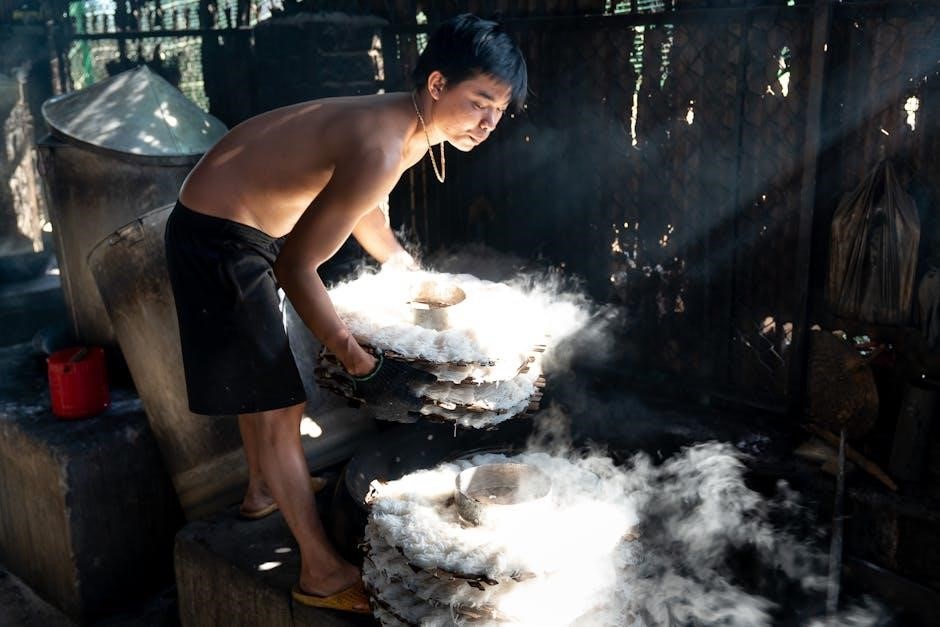The Quadra Fire Pellet Stove offers efficient and reliable heating solutions, designed for easy operation and environmental efficiency. It is suitable for various spaces, including mobile homes, with proper installation.

Key Components of the Quadra Fire Pellet Stove
The Quadra Fire Pellet Stove features a control board, heat exchanger, igniter, and hopper, each playing a crucial role in its efficient and safe operation, ensuring optimal heating performance and reliability.
1.1 Control Board
The control board is the central nervous system of the Quadra Fire Pellet Stove, managing operations like ignition, fuel flow, and temperature settings. It ensures the stove operates efficiently and safely by monitoring and adjusting various functions. Proper installation and maintenance of the control board are essential to prevent malfunctions. Regularly check for software updates and follow the manufacturer’s guidelines for optimal performance. If issues arise, refer to the user manual or contact a certified technician. The control board’s advanced features allow seamless adjustments, making it user-friendly and reliable for consistent heating. Always ensure it is correctly installed and maintained to uphold the stove’s efficiency and safety standards. This component is vital for the overall functionality of the pellet stove, ensuring a smooth and controlled operation. By adhering to maintenance routines, users can extend the lifespan of the control board and the stove.
1.2 Heat Exchanger
The heat exchanger is a critical component of the Quadra Fire Pellet Stove, designed to maximize efficiency by transferring heat from combustion to the surrounding air. It ensures that the stove operates efficiently while maintaining safety standards. Proper maintenance of the heat exchanger is essential to prevent damage and ensure optimal performance. Regular cleaning is recommended to remove soot and debris, which can accumulate and reduce heat transfer. The heat exchanger is typically made of durable materials to withstand high temperatures and prolonged use. If you notice any damage or wear, contact a professional for repairs to avoid further issues. A well-maintained heat exchanger not only improves heating efficiency but also extends the lifespan of the stove. Always follow the manufacturer’s guidelines for cleaning and maintenance to ensure safe and effective operation.
1.3 Igniter
The igniter is a crucial component of the Quadra Fire Pellet Stove, responsible for initiating combustion by igniting the pellets. It typically consists of an electric element that glows hot when activated, starting the fire. Proper functioning of the igniter is essential for consistent and reliable operation. If the igniter becomes dirty or damaged, it may fail to ignite the pellets, leading to startup issues. Regular cleaning of the igniter is recommended to ensure optimal performance. If the igniter is faulty, it may need to be replaced to restore proper operation. Always refer to the manufacturer’s instructions for guidance on inspecting and maintaining the igniter. A malfunctioning igniter can be identified if the stove fails to start or if the ignition process is inconsistent. Addressing issues promptly ensures safe and efficient heating. Never attempt to repair the igniter while the stove is in operation or plugged in.
1.4 Hopper
The hopper is a vital part of the Quadra Fire Pellet Stove, serving as the storage compartment for wood pellets. It ensures a steady fuel supply to the combustion chamber. The hopper’s capacity varies by model, allowing extended operation without frequent refueling. Proper loading is essential; pellets should be added without overfilling to prevent jams or damage. Regular cleaning of the hopper is recommended to remove ash and debris, ensuring smooth operation. If the hopper becomes clogged, it can disrupt the fuel flow, leading to performance issues. Always use high-quality pellets recommended by the manufacturer to maintain efficiency and safety. The hopper’s design allows for easy access, making maintenance straightforward. Monitoring pellet levels ensures continuous operation, and refueling should be done when the stove is cool to avoid safety hazards. A well-maintained hopper contributes significantly to the stove’s overall efficiency and reliability. Always follow the manufacturer’s guidelines for hopper maintenance and pellet usage.

Installation Requirements
Ensure compliance with local building codes and manufacturer guidelines. Use a Quadra-Fire Outside Air Kit for proper ventilation. The stove must be installed in accordance with OAR 814-23-900 for manufactured homes.
2.1 Pre-Installation Checks
Before installing the Quadra Fire Pellet Stove, ensure the location meets all safety and regulatory requirements. Verify clearance distances from combustible materials and ensure proper venting capabilities. Check local building codes and ensure the stove is suitable for your space, including mobile homes. Inspect the area for any obstructions and ensure the floor is level. Confirm the availability of a dedicated electrical outlet and proper ventilation pathways. Ensure the Quadra-Fire Outside Air Kit is used if required for direct venting. Review the manufacturer’s guidelines for specific model recommendations. Finally, consult a certified installer to ensure compliance with all safety standards and regulations, including OAR 814-23-900 for manufactured homes.

2.2 Venting Requirements
Proper venting is crucial for safe and efficient operation of the Quadra Fire Pellet Stove. Install a Class II chimney or pellet vent system, ensuring it meets local building codes and manufacturer specifications. The venting system must be dedicated solely to the pellet stove and designed to handle combustion byproducts. Use a UL-listed pellet vent pipe, as it is specifically designed for high temperatures and corrosive gases. Ensure the venting system is properly insulated and clear of combustible materials. Install the vent according to the manufacturer’s instructions, maintaining the required clearance distances. If installing in a mobile home, ensure compliance with OAR 814-23-900. A professional inspection is recommended to ensure the venting system is installed correctly and safely. Proper venting ensures efficient performance and minimizes the risk of hazards such as carbon monoxide buildup;

Daily Operating Instructions
Ensure the stove is clean and fueled with recommended pellets. Follow the control board instructions for ignition and heat adjustment. Monitor pellet levels and combustion efficiency daily for optimal performance.
3.1 Starting the Stove
To start the Quadra Fire Pellet Stove, ensure it is properly installed with the recommended venting system and Outside Air Kit. Open the stove door and verify the hopper contains the correct type of pellets. Turn on the power supply and follow the control board instructions to initiate the ignition process. Once the igniter activates, wait for the fire to establish before closing the door. Ensure the burn pot is clear of debris and the ash pan is empty for optimal performance. Refer to the manual for specific ignition sequences and safety precautions. Always monitor the stove during startup and operation to ensure safe and efficient burning. Regular checks of the burn pot and ash pan are essential for maintaining proper function.
3.2 Adjusting Heat Output
To adjust the heat output of your Quadra Fire Pellet Stove, use the control board to select from low, medium, or high settings. The stove’s feeder system will automatically adjust the pellet flow based on the selected heat level; For precise control, refer to the manual for specific instructions on customizing the feed rate. Higher settings will increase both heat output and pellet consumption. Monitor the stove’s temperature display and adjust as needed to maintain your desired comfort level. Ensure the venting system is functioning properly, as this directly impacts heat efficiency. Regularly clean the burn pot and ash pan to ensure consistent performance. Always follow the manufacturer’s guidelines for adjusting settings to avoid overloading the system. Proper adjustment ensures efficient heating and extends the stove’s lifespan.
